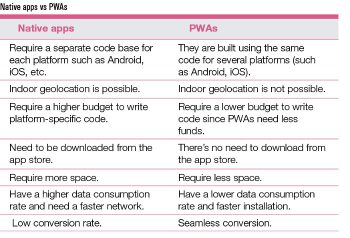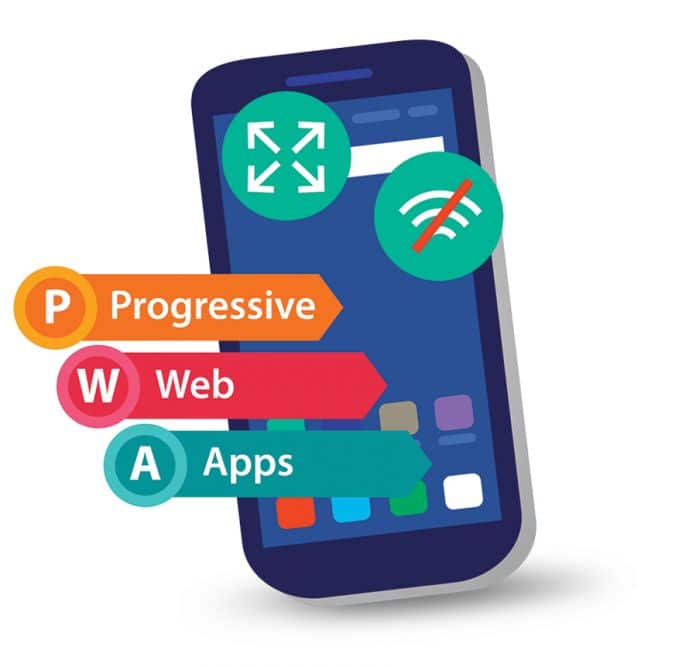A progressive Web app (PWA) is one that uses modern Web capabilities to deliver an app-like experience to users. It is built using common Web technologies like HTML, CSS and JavaScript, and is designed to work on any device that has a standards-compliant browser. PWAs are browser- and platform-agnostic.
Momobills is an invoice maker and billing software based progressive mobile application (PWA) developed by Shreyas Software Private Limited. Grocery shop owners can use this software to send e-bills to customers who have just shopped without the hassle of any point of sale (POS) device. These e-bills can even be printed by thermal printers or POS terminals. The software also comes with integrated Bluetooth thermal print support.
This is just one example of a PWA, which is the latest trend in the Web application sector. Imagine a world in which everything is connected and communicates with the Web — PWAs will play a very significant role in such a world.
The gadget world is full of apps, some of which are excellent, covering aspects from gaming to news reading. Web applications are an integral part of the Web world, though they are sometimes neglected by developers. Apps have taken off in a big way and have already crossed a turnover of US$ 6 trillion globally.
More than 50 per cent of Internet users have depended on mobiles for all their online activities since 2018. However, the slightest delay while downloading Web apps irks users. To resolve this issue, Google introduced PWAs in 2015.
PWAs are a blend of native apps and Web apps in the functions they provide. Google depends heavily on PWA development for its services like weather reports, restaurant reviews and locations, traffic conditions, and the scores of sports events. Aliexpress, Alibaba’s consumer shopping platform, found considerable increase in its performance once it began using a PWA.
PWAs are changing the look of native apps. More importantly, Microsoft (Edge), Apple (Safari) and last but not least, Google (Chrome), all provide ongoing maintenance to PWAs. Directories like Outweb.io and PWA Rocks offer a collection of PWAs in one place.
Today there are about 2 million apps in the Apple Store and almost double that in the Android store. Not all of these apps are downloaded and used, and your mobile certainly doesn’t have the space for all of them. Many website owners tried to take advantage of this fact, and that led to the development of PWAs.
Introduced in 2015, progressive Web apps have gained popularity over the years. Google, Apple, Microsoft and other such technical giants are all slowly transitioning to PWAs because of the flexibility of these apps.
PWAs have so far delivered great results for businesses as they involve less data usage and a quick loading time. They improve the user experience and also user retention rates. They make the app more secure and cost less to develop.
Characteristics of PWAs
The essential features of PWAs are:
- A home screen icon
- Push notifications
- Splash screen
- Geolocation
- Offline mode
- Background synchronisation
- Media access from audio and video devices
- The latest technology
- Secured
- Provide a super-rich experience
- No app store is required
 The adoption of PWAs by Pinterest resulted in a 60 per cent hike in its engagements and a 44 per cent increase in advertisement revenue. The time visitors spent on the site also increased by 40 per cent. Tinder reduced its loading time from 11.91 seconds to 4.69 seconds with its new PWA. BookMyShow’s PWA has helped it to increase conversion rates by over 80 per cent. Twitter had a 75 per cent increase in tweets sent and a 20 per cent fall in bounce rates when it used a new PWA. Pure Formulas is a leading online health and supplements company based in the US. By introducing PWAs, the company has enjoyed a 14 per cent increase in conversions, a 9 per cent increase in average order value (AOV) and a 23 per cent increase in revenue per visit.
The adoption of PWAs by Pinterest resulted in a 60 per cent hike in its engagements and a 44 per cent increase in advertisement revenue. The time visitors spent on the site also increased by 40 per cent. Tinder reduced its loading time from 11.91 seconds to 4.69 seconds with its new PWA. BookMyShow’s PWA has helped it to increase conversion rates by over 80 per cent. Twitter had a 75 per cent increase in tweets sent and a 20 per cent fall in bounce rates when it used a new PWA. Pure Formulas is a leading online health and supplements company based in the US. By introducing PWAs, the company has enjoyed a 14 per cent increase in conversions, a 9 per cent increase in average order value (AOV) and a 23 per cent increase in revenue per visit.
To put it simply, PWAs are Web applications that load in a Web browser just like Web pages or websites. They give users a rich mobile experience via native-like functionalities such as the ability to work offline, push notifications and device hardware accessibility.
Some of the situations in which PWAs are exceedingly useful are:
- The increased app size
- Infrequent use of the app
- Low Internet connectivity
- Big Data and storage consumption
- Frequent updates and permissions
The number of alternatives for a particular purpose, such as food delivery, e-commerce and so on
Tools to develop PWAs
PWAs will replace 50 per cent of native apps by 2020. Today, thousands of companies around the world are building PWAs. Every company wants to jump into PWA development to be able to deliver better services. Web standard technologies like JavaScript, HTML and CSS are required to build PWAs.
Early 2010 experienced dynamic Web pages that allowed technologies such as interactive Web applications, responsive Web design and screen-size flexibility. These helped the growth of PWAs to a great extent.
The following tools are very useful in the development of PWAs:
- Pwa.rocks offers examples of excellent solutions under several categories, including business, shopping and games.
- Google Developers provides resources that help to code and has a comprehensive PWA checklist.
- For example, the Lighthouse extension allows you to audit Web pages to determine if they qualify as PWAs.
- PWA Builder takes data from your website for easy and fast generation of the PWA.
- Knockout is a JavaScript library that helps you to create the display and edit user interfaces.
- Angular and React are excellent JavaScript frameworks for PWA development.
The disadvantages of PWAs
- PWAs consume more battery power compared to native apps because they are written in high-level Web code.
- The features of PWAs are still relatively new to most developers.
- There are no budgets for PWA development within companies. So Web developers should be given opportunities, along with support in terms of money and time, to explore this new technology.
- PWAs can’t access various device features. For example, they can’t access a device’s Near Field Communication (NFC). PWAs also can’t access a device’s Bluetooth, proximity sensors, ambient light, advanced camera controls, geofencing, wake lock, contacts and more.
Because of these reasons, many users are still not very familiar with PWAs.
Challenges
PWAs require application architecture, including event management, state and caching. Further, team members at the front-end, back-end and those working on the full stack should be trained in the new structures and tool chain. PWA-building expertise needs to go beyond JQuery and HTML.
Open source technologies such as Angular or React are just libraries for the user interface (UI). They provide low-level tools for managing events and state. Progressive generators solve only the most straightforward part of building a PWA, such as generating the manifest or essential service worker. Besides, they don’t come with out-of-the-box integration for significant e-commerce and marketing platforms. Nor can they optimise battle-hardened components for speed and conversion.
Making PWAs run forever
The Indian PWA development industry is quite mature compared to various other countries. It caters not only to a thriving and challenging domestic market but also to the global market. As the needs of the market evolve, the features of PWAs also change from time to time. PWAs can become the future of Web development provided they keep pace with rapid changes in technology.
If a company can put together the best PWAs money can buy, super-efficient Web app programmers and decades of Web app-making know-how, then, theoretically, a Web device might run forever.












































































